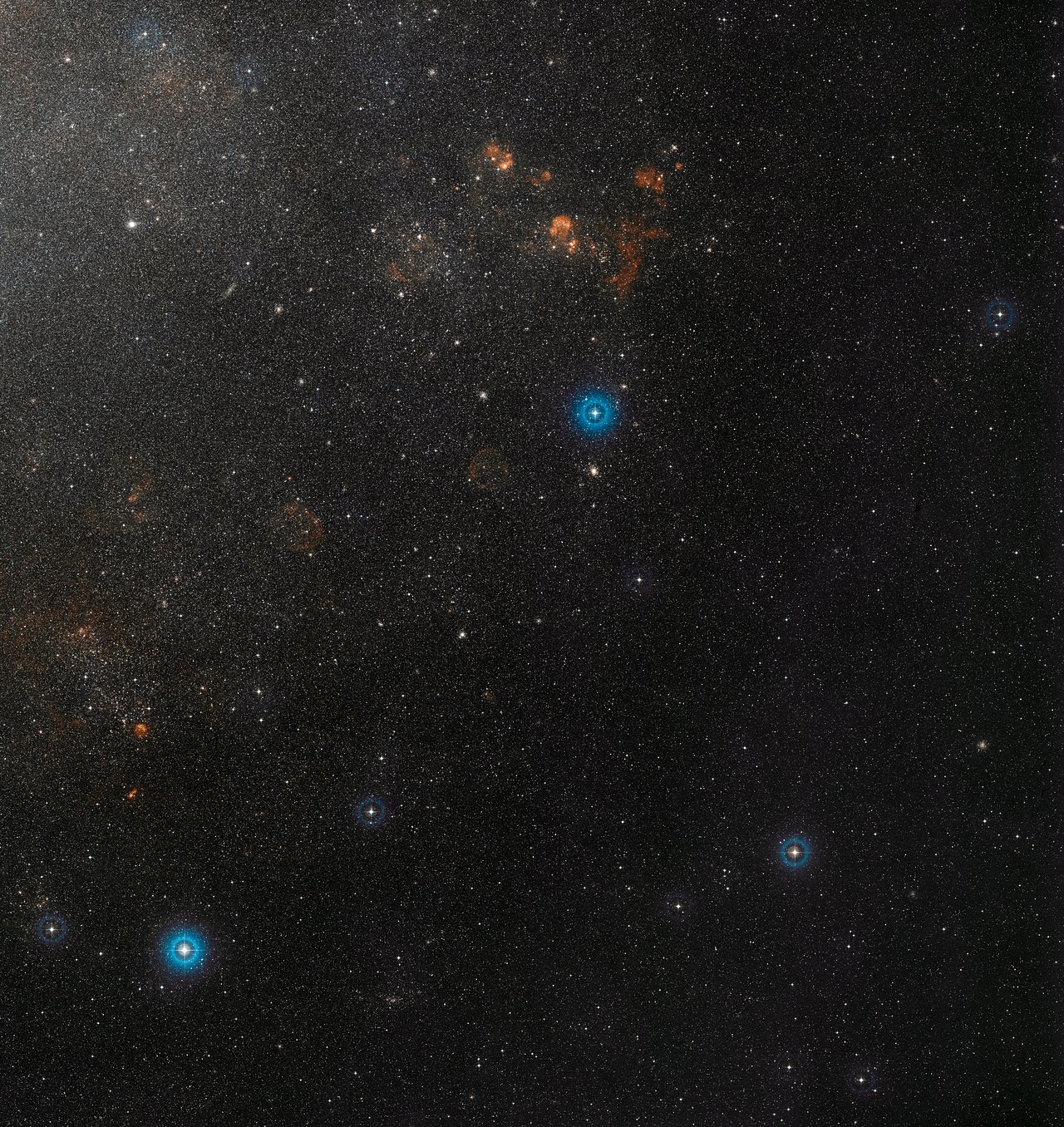European Southern Observatory | 24 Nov 2010
The dynamical mass of a classical Cepheid variable star in an eclipsing binary system G Pietrzyński et alBy discovering the first double star where a pulsating Cepheid variable and another star pass in front of one another, an international team of astronomers has solved a decades-old mystery. The rare alignment of the orbits of the two stars in the double star system has allowed a measurement of the Cepheid mass with unprecedented accuracy. Up to now astronomers had two incompatible theoretical predictions of Cepheid masses. The new result shows that the prediction from stellar pulsation theory is spot on, while the prediction from stellar evolution theory is at odds with the new observations.
- This wide field view of part of the Large Magellanic Cloud was created from photographs taken in red and blue light as part of the Digitized Sky Survey 2. The remarkable double star OGLE-LMC-CEP0227 lies at the center of the picture, just one of huge numbers of faint stars. Studies of this very rare system have allowed astronomers to measure mass of a Cepheid variable star with unprecedented accuracy. [i](Credit: ESO/DSS2. Acknowledgement: Davide de Martin)[/i]
The new results, from a team led by Grzegorz Pietrzyński (Universidad de Concepción, Chile, Obserwatorium Astronomiczne Uniwersytetu Warszawskiego, Poland), appear in the 25 November 2010 edition of the journal Nature.
...
Classical Cepheid Variables, usually called just Cepheids, are unstable stars that are larger and much brighter than the Sun. They expand and contract in a regular way, taking anything from a few days to months to complete the cycle. The time taken to brighten and grow fainter again is longer for stars that are more luminous and shorter for the dimmer ones. This remarkably precise relationship makes the study of Cepheids one of the most effective ways to measure the distances to nearby galaxies and from there to map out the scale of the whole Universe.
Unfortunately, despite their importance, Cepheids are not fully understood. Predictions of their masses derived from the theory of pulsating stars are 20–30% less than predictions from the theory of the evolution of stars. This embarrassing discrepancy has been known since the 1960s.
To resolve this mystery, astronomers needed to find a double star containing a Cepheid where the orbit happened to be seen edge-on from Earth. In these cases, known as eclipsing binaries, the brightness of the two stars dims as one component passes in front of the other, and again when it passes behind the other star. In such pairs astronomers can determine the masses of the stars to high accuracy. Unfortunately neither Cepheids nor eclipsing binaries are common, so the chance of finding such an unusual pair seemed very low. None are known in the Milky Way.
...
The observers carefully measured the brightness variations of this rare object, known as OGLE-LMC-CEP0227, as the two stars orbited and passed in front of one another. They also used HARPS and other spectrographs to measure the motions of the stars towards and away from the Earth — both the orbital motion of both stars and the in-and-out motion of the surface of the Cepheid as it swelled and contracted.
This very complete and detailed data allowed the observers to determine the orbital motion, sizes and masses of the two stars with very high accuracy — far surpassing what had been done before for a Cepheid. The mass of the Cepheid is now known to about 1% and agrees exactly with predictions from the theory of stellar pulsation. However, the larger mass predicted by stellar evolution theory was shown to be significantly in error.
The much-improved mass estimate is only one outcome of this work, and the team hopes to find other examples of these remarkably useful pairs of stars to exploit the method further. They also believe that from such binary systems they will eventually be able to pin down the distance to the Large Magellanic Cloud to 1%, which would mean an extremely important improvement of the cosmic distance scale.
- Nature 468(7323) 542 (25 Nov 2010) DOI: 10.1038/nature09598


